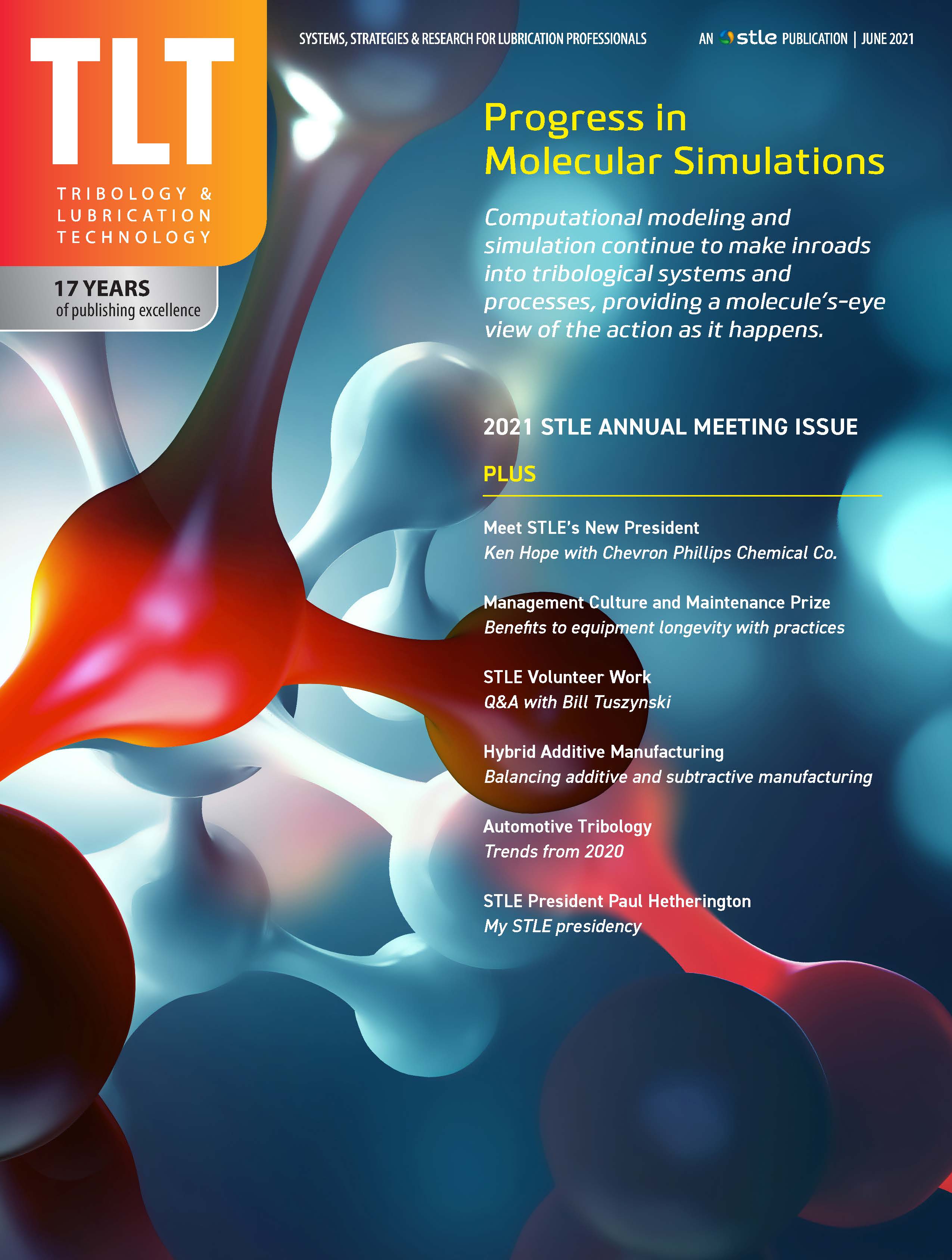Selected as Cover Image
Our figure was selected as cover image of Sci. Adv.Y. Ishii, N. Matubayasi, G. Watanabe, T. Kato, H. Washizu, "Molecular insights on confined water in the nanochannels of self-assembled ionic liquid crystal", Sci. Adv., 7 (31) eabf0669 (2021). pdf.

Our research is on STLE journal
Our research of molecular simulatino on Tribology is reviewd in TLT (Tribology & Lubrication Technology June 2021) . Please read "Progress in tribological molecular simulations" in page 42.
A new national project
The new national project NEDO Automotive engine is started!5 years anniversary, since 2015!
Thanks for all of your support! Dr. Deboprasad Talkudar joined our lab today.A new national project
The new national project NEDO Wind Trubine started!A new national project Aquatic Functional Materials starts!
Japan Society for the Promotion of Science (JSPS) Grant-in-Aid for Scientific Research on Innovative Areas (2019-2023) Aquatic Functional Materials, Creation of New Materials Science for Environment-Friendly and Active Functions starts! Dr. Yoshiki Ishii have joined our lab.!MMM2018
We organized special session of Tribology and Interface the 9th Multiscale Materials Modeling (MMM). Thank you for your kind collaboration.2018 JSME-IIP/ASME-ISPS(MIPE 2018) Joint Conference on Micromechatronics for Information and Precision Equipment
HW and Prof. Hedong Zhang (Nagoya Univ) organized "Advanced Simulation in Science and Engineering" session at this conference. August 29-30, 2018, Hilton San Francisco Financial District, San Francisco, California, USA. Thank you for your kind collaboration.Mr. Kohei Nishikawa (M2) won "Certificate of Merit for Best Presentation" from The Japan Scociety of Mechanical Engineers. Congratulations!
2 Master Course Students won award at 6th World Tribology Congress (WTC2017).
In 19 Sep, H. Akiyama (M2) and M. Konishi (M2) made presentation and won the "Best Poster Award" in 6th World Tribology Congress (WTC2017) at Beijing, China. This conference is the largest conference in Tribology field, held every 4 years, like the Olympic game. Congratulations!Invited Talk
This summer we made invited talks at The 8th Advanced Forum on Tribology 2017, Zhenjiang . The title was "Tribological Simulations for Carbon Based Materials". We will also make 3 presentations at 6th World Tribology Congress 2017 , Beijing.Master Course Student won award at MJTS2017, Kuala Lumpur, Malaysia.
In 29 Aug, M. Konishi (M2) made presentation and won the "Best Poster Award" in 5th Malaysia-Japan Tribology Symposium (MJTS2017). Congratulations!Master Course Students joined STLE2017 at Atlanta, GA, USA.
In 22 May, H. Akiyama (M2) and M. Konishi (M2) made presentations in STLE 2017 annual meeting. Thank you for kind discussions.Student award
Mr. Maeda (MS student) won a " 2016 Student Award" from the Japanese Society of Tribologists. The title of the paper is "Mechanism of ultra-low friction of multilayer graphene studied by all atom molecular dynamics". Congratulation!Invited Talk
This summer we made invited talks at CECAM workshop on Interactions and Transport of Charged Species in Bulk and at Interfaces (Vienna) and 4th Malaysia-Japan Tribology Symposium (Kuala Lumpur).Paper award
We won an award of Tribology Online 2015. S. Kajita, M. Tohyama, H. Washizu, S. Ohmori, K. Watanabe, S Shikata, "Friction modification by shifting of phonon energy dissipation in solid atom", Tribology Online 10, (2) 156-161 (2015). https://www.jstage.jst.go.jp/article/trol/10/2/10_156/_pdfGuide for Application for the graduate students on Master and Ph.D. Program in 2019.
We are looking for Master and PhD students to join the next generation of outstanding researchers in molecular simulation. The candidate must pass the entrance exam and the Japanese-Language Proficiency Test N2. Though the research advisor can teach in English, the candidate need to understand Japanese to study the usual lectures in the curriculum.
Recent Publications
Le Van Sang*, N. Sugimura, H. Washizu*, "Influence of the alumina ceramic coating on friction and stability of the iron contacts", ASME. J. Tribol. (published online). pdf,The study focuses on monitoring influence of the alumina coatings on friction and stability of the microscale iron contacts by the smoothed particle hydrodynamics. The obtained results show a better stability and a higher value of the friction coefficient of the coated surface compared to the uncoated one. This study also supposes that in concern of stability of the surface the coating should be done with only the substrate surface accompanied with the roughness of the coating layer. The proportion of the coated particles is found to be strongly resulting in the friction properties and the roughness of the coating layer also slightly results in those. The surface reaches the most stability at the proportion of around 70%.
Le Van Sang*, A. Yano, S. Fujii, N. Sugimura, H. Washizu*, "Friction and friction heat of micronscale iron", ASME. J. Tribol. 142(9): 091702 (2020). pdf, pdf (arxiv)
This paper investigates the friction and friction heat of the micronscale iron under the influences such as the velocity of the slider and temperature of the substrate by using the smoothed particle hydrodynamics simulations. It is found that in the velocity range of 10-100 m/s, the sliding velocity-friction coefficient relationship well complies with the fitted exponent or hyperbolic tangent function, and the friction coefficient approaches a stable value of 0.3 at around the velocity of 50 m/s after a rapidly increasing situation. The steady friction coefficient maintains over the temperature range of 200-400 K. The friction heat is detailed analyzed versus the sliding time. The sliding time-system temperature relationship is well fitted by the sigmoidal functions, except the interfacial particle layers. The layer causing friction shows the highest steady temperature and largest temperature rise. The increment between the initial temperatures of the slider and the substrate strongly results in the temperature rise while it does not affect the configuration of the sliding time-system temperature curves.
H. Yoshida, T. Kinjo, H. Washizu, "Numerical simulation method for Brownian particles dispersed in incompressible fluids", doi.org/10.1016/j.cplett.2019.136809 pdf, pdf (arxiv)
We present a numerical scheme for simulating the dynamics of Brownian particles suspended in a fluid. The motion of the particles is tracked by the Langevin equation, whereas the host fluid flow is analyzed by using the lattice Boltzmann method. The friction force between a particle and the fluid is evaluated correctly based on the velocity difference at the position of the particle. The coupling method accurately reproduces the long-time tail observed in the velocity auto-correlation function. We also show that the fluctuation-dissipation relation holds between the relaxation of a single particle and the velocity autocorrelation function of fluctuating particles.
Le Van Sang*, A. Yano, A. Isohashi, N. Sugimura, H. Washizu*, "Smoothed particle hydrodynamics study of friction of the coarse-grained a-Al2O3/a-Al2O3 and a-Fe2O3/a-Fe2O3 contacts in behavior of the spring interfacial potential", Trib. Intl., DOI: 10.1016/j.triboint.2019.03.015 (2019). pdf, pdf (arxiv), Free in 50 days
The paper investigates sliding friction of the a-Al2O3/a-Al2O3 and a-Fe2O3/a-Fe2O3 contacts by using the spring interfacial potential. It is found that at micronscale the friction properties of the oxides are almost independent of the coarse-graining and are the same in the different sliding directions. Even the hardness contacts friction coefficient shows a decrease with increasing intensity of the normal component of the interfacial interaction force. This result is as an implementation for the previous observations of sliding friction of various materials that showed that a drop of friction coefficient with increasing externally applied normal load has originated from deformation of interfaces or occurrence of debris at contact, indicating an unsteady contact.
M. Konishi, H. Washizu, "Understanding the effect of the base oil on the physical adsorption process of organic additives using molecular dynamics", Trib. Intl., 149, 105568 (2020). pdf, pdf (arxiv)
Organic friction modifiers (OFMs) are widely added to oil to reduce the boundary friction in many kinds of lubricants such as vehicle engine oils. At the contact area in machine elements, the OFMs form a self-assembled organic monolayer. Although the friction properties of the monolayer are widely studied on a molecular level, the formation process is not well-known. In this study, the initial adsorbing process of additive molecules in explicit base oil molecules are calculated using molecular dynamics. The adsorption time depends on the structure of the base oils. Another effect of the base oil other than "chain matching" is found.
K. Nishikawa, H. Akiyama, K. Yagishita, H. Washizu, "Molecular dynamics analysis of adsorption process of anti-copper-corrosion additives to the copper surface", Jurnal Tribologi 21 (2019) 63-81. pdf
As a model system of the adsorption process of anti-corrosion additives on a metal surface, molecular dynamics simulations of benzotriazole (BTA) molecules with copper slabs were completed. As a force field, ReaxFF was used to simulate both adsorption dynamics and the charge transfer on the solid surface. Two simulations are presented. In order to investigate the physical adsorption on the surface, the simulation was done for the adsorption process of BTA molecules on the copper (II) oxide slab. BTA molecules formed on adsorbed layer in parallel to the surface, and aggregation of the molecules due to the surface diffusion was found. In order to investigate the selective and chemical adsorption on the surface, a hybrid slab, which has both a copper (Cu) area and a copper (I) oxide (Cu2O) area, was used. A selective adsorption phenomenon was found. The number of BTA molecules adsorbed on the Cu area is 5 times greater than that on the Cu2O area. Detailed dynamics focused on charge transfer showed a surface diffusion and enhancement of polarization due to charge transfer from the metal surface caused the selective adsorption. In a real phenomenon, the reason why a few anti-corrosion additives are able to protect a metal surface is postulated to be due to this selective nature of adsorption onto a newly formed metal surface.
